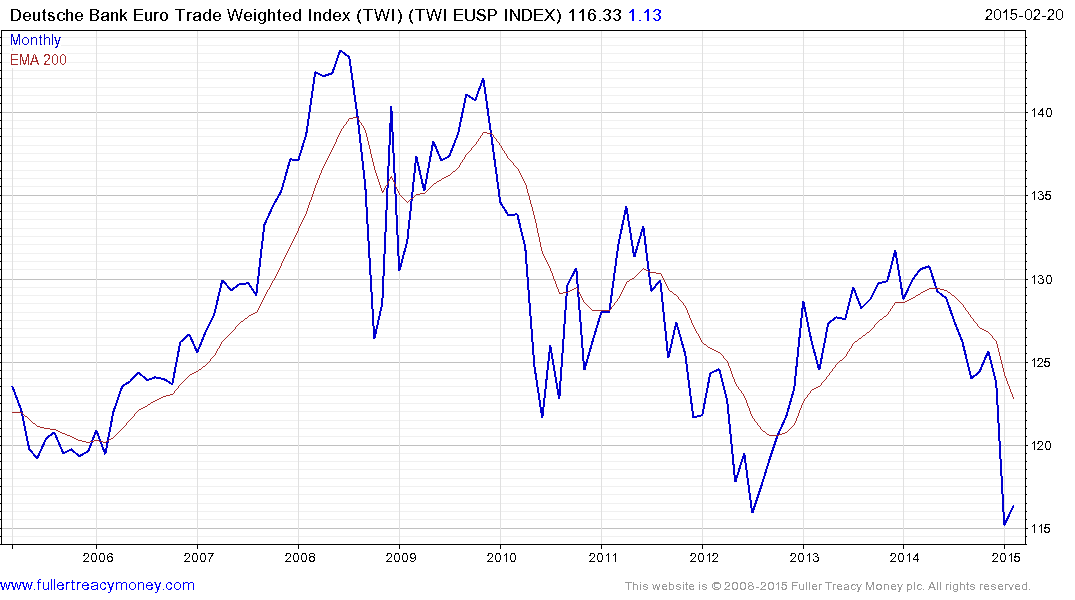Hedge Your European Exposure With This Savvy ETF_1
Post on: 12 Июнь, 2015 No Comment

StreetAuthority Active Member Official Contributor
The European Central Bank's (ECB) recent announcement of a huge bond-buying program has made investors understandably giddy. The move could help jumpstart Europe's flagging economy.
Moreover, a similar program of so-called quantitative easing by the Federal Reserve was a major tailwind in the multi-year run-up of U.S. stocks to all-time highs. So investors are anticipating a similar effect on European stocks from ECB stimulus.
The impact on exchange-traded funds (ETFs) that invest in European stocks, bonds and commodities is already evident, as they are seeing record inflows. In January, these funds took in an all-time one-month high of $13.7 billion, with the lion's share going to equity-focused ETFs, according to BlackRock, Inc. (NYSE: BLK ).
European stocks have risen nearly 5% thus far in 2015, based on the performance of the MSCI EAFE (Europe, Australasia and Far East) Index. In contrast, the S&P 500 is roughly flat thus far this year.
If you're bullish on Europe, then there's a key risk factor to consider before you dive in: the strong U.S. dollar. The greenback is at a 10-year high against a basket of foreign currencies, including the euro.
For U.S. investors, a strong dollar can take a bite out of foreign investments, which are generated in foreign currencies and then converted to dollars. When the dollar is so strong, some profits are lost in the exchange. Since European QE is likely to weaken the euro even further against the dollar, the issue is especially poignant for investors eyeing further returns from the region.
That's why I'd recommend hedging against the surging dollar with the Deutsche X-trackers MSCI EAFE Hedged Equity ETF (NYSE: DBEF ). a broadly diversified Europe-focused ETF designed to minimize currency risk.
The fund, which has total assets of $3.4 billion, provides a hedge by tracking the MSCI EAFE U.S. Dollar Hedged Index. As such, DBEF uses forward currency contracts, or forwards, to lock in the best exchange rates for the currencies in the portfolio on a monthly basis.
This sort of currency hedging isn't flawless. Currency forwards are binding contracts, so DBEF doesn't have the option of walking away if it finds out later that some contracts were locked in at unfavorable exchange rates.
What's more, the fund's currency hedges and overall composition may not always match those of its benchmark, since there is constant fluctuation in a range of variables such as exchange rates, security prices, benchmark weightings and hedging costs, to name a few.
Still, DBEF's dollar hedge is providing a clear performance advantage. The fund's year-to-date return is about 2% greater than that of the MSCI EAFE Index. Its three-year rate of return of 14.5% bests the MSCI EAFE by 5.5% annually.
The fund itself is spread over more than 900 stocks and 22 countries. At 21% of fund assets, the United Kingdom is the area of greatest exposure in Western Europe. Like its benchmark, DBEF also makes substantial allocations to other major European economies such as Germany, France, Norway, Switzerland, Italy and Spain.
About a third of fund assets are invested in developed regions of Greater Asia, mainly Japan, which has a portfolio weighting similar to the U.K. Much smaller portions of fund assets are allocated to Australia, Hong Kong and Singapore.
As the following list shows, 13 of DBEF's top 15 holdings are European companies.
This fund has roughly 90% of its funds invested in very large companies, which typically hold great appeal with conservative investors. The typical portfolio holding has an average market value of $34 billion. Moreover, DBEF has negligible exposure to China and other, riskier Asian emerging markets.
Despite the added trading costs associated with currency hedging, the fund maintains a very reasonable 0.35% expense ratio. It has an attractive dividend yield of 4.9%, compared with about 3.7% for unhedged ETFs that simply track the MSCI EAFE Index.
Risks To Consider: European QE may fail. ECB President Mario Draghi himself cautioned that monetary stimulus alone isn't enough to rescue the Eurozone economy. European governments will also need to undertake much-needed structural changes. Japan, which is facing recession, too, has undertaken multiple QE programs spanning many years. Its stock market has barely returned to pre-financial-crisis levels and is nowhere near the highs of its heyday in the late 1980s .
Action To Take —> There are risks to investing in Europe, so it's important to go in with eyes wide open. Many experts are highly critical of the region's new QE program. But that certainly doesn't guarantee failure, and the program already appears to be lifting European stocks even though bond purchases don't officially begin until March. If you'd like broad exposure to the region, then the DBEF provides a savvy risk-adjusted approach.
Looking for more options to invest internationally? High-Yield International is your best source for investing trends, opportunities and sky-high yields abroad. In fact, 79% of the world's highest-yielding stocks are overseas. For more information about international investing, click here.














